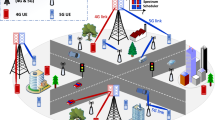Abstract
In this paper, the Wideband Code Division Multiple Access (WCDMA) downlink capacity and the interference statistics of long tunnel cigar-shaped microcells are analyzed. The hybrid model of propagation is used in the analysis where a model of 10 cigar-shaped microcells is used. The downlink capacity is given for different sector radio R, break point distance R b and propagation parameters (s and γ). It is found that the effect of changing the value of the propagation parameter s is very small. Also, it is noticed that, increasing the propagation parameter γ will increase the sector downlink. It is found that, the effect of changing the break point distance R b is quasi null. Finally it is noticed that the imperfect power control reduces the downlink capacity by 4 %.










Similar content being viewed by others
References
Ahmed, B. T. (2009). WCDMA downlink capacity of cigar-shaped microcells for underground metro service. European Transactions on Telecommunications, 20, 447–455.
Ahmed, B. T., & Ramon, M. C. (2007). WCDMA downlink capacity of cigar-shaped microcells using soft hand-over with SIR-based power control for over-ground train service. Computer Communications, 31(1), 88–94.
Ahmed, B. T., Ramon, M. C., & Ariet, L. H. (2002). Capacity and interference statistics of highways W-CDMA cigar-shaped microcells (uplink analysis). IEEE Communications Letters, 6(5), 172–174.
Ahmed, B. T., Ramon, M. C., & Ariet, L. H. (2004). W-CDMA uplink capacity and interference statistics of a long tunnel cigar-shaped microcells using the hybrid model of propagation with imperfect power control. Wireless Personal Communications, 31, 19–31.
Assaad, M., Jouaber, B., & Zeghlache, D. (2004). TCP performance over UMTS-HSDPA system. Telecommunication Systems, 27(2–4), 371–391.
Briso-Rodríguez, C., Cruz, J. M., & Alonso, J. I. (2007). Measurements and modeling of distributed antenna systems in railway tunnels. IEEE Vehicular Technology, 56(5), 2870–2879.
Chen, L., & Yuan, D. (2011). Coverage planning for optimizing HSDPA performance and controlling R99 soft handover. Telecommunication Systems, published on line.
Chen, Y., & Cuthbert, L. (2002). Optimum size of soft handover zone in power controlled UMTS downlink systems. Electronics Letters, 38(2), 89–90.
Holma, H., & Toskala, A. (2002). WCDMA for UMTS. New York: Wiley.
Lee, C. C., & Steele, R. (1993). CDMA for city street microcells. In IEE colloquium on spread spectrum techniques for radio communication systems (pp. 3/1–3/10).
Mehailescu, C., Lagrange, X., & Godlewski, P. (1999). Soft handover analysis in downlink UMTS WCDMA system. In IEEE MoMuC, San Diego, CA (pp. 279–285).
Parniewicz, D., Stasiak, M., & Zwierzykowski, P. (2011). Analytical model of the multi-service cellular network servicing multicast connections. Telecommunication Systems, published on line.
Van Cauwenberge, S. N. P. (2003). Study of soft handover in UMTS. Master Thesis, Technical University of Denmark.
Viterbi, A. J., Viterbi, A. M., Gilhousen, K. S., & Zehavi, E. (1994). Soft handoff extends CDMA cell coverage and increases reverse link capacity. IEEE Journal on Selected Areas in Communications, 12(8), 1281–1288.
Wong, D., & Lim, T. J. (1997). Soft handoffs in CDMA mobile systems. IEEE Personal Communications, 4(6), 6–17.
Yang, X., Ghaheri-Niri, S., & Tafazolli, R. G. (2001). Downlink soft handover gain in CDMA cellular network with cross-correlated shadowing. In IEEE veh. technology conf. VTC (Vol. 1, pp. 276–280).
Zhang, D., Wei, G., & Zhu, J. (2002). Performance of hard and soft handover for CDMA system. In IEEE veh. technology conf. VTC (Vol. 2, pp. 1143–1147).
Zhang, Y. P. (2000). A hybrid model for propagation loss prediction in tunnels. In Millennium conference on antennas & propagation, Davos, Switzerland.
3GPP TSG RAN 25.331 V.5.2.0 (2002). Radio resource control (RRC), protocol specification.
Author information
Authors and Affiliations
Corresponding author
Rights and permissions
About this article
Cite this article
Ahmed, B.T. WCDMA downlink capacity of cigar-shaped microcells for long tunnels. Telecommun Syst 57, 229–237 (2014). https://doi.org/10.1007/s11235-013-9842-7
Published:
Issue Date:
DOI: https://doi.org/10.1007/s11235-013-9842-7




